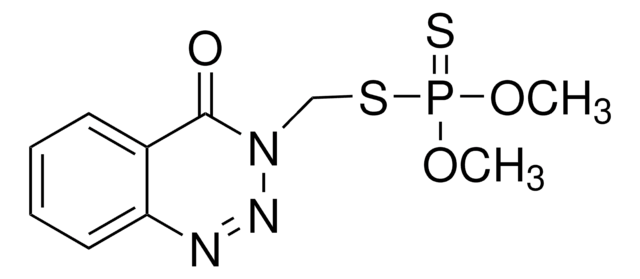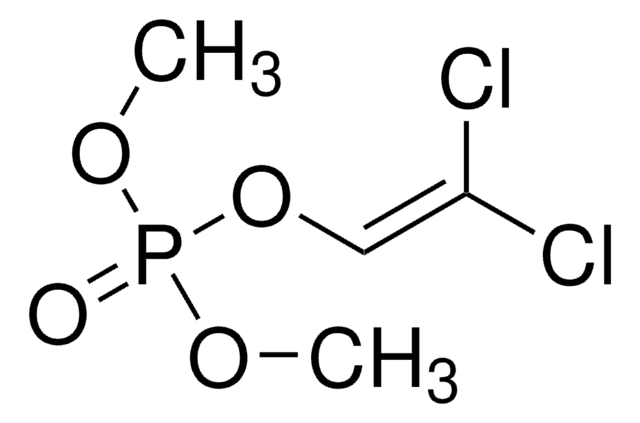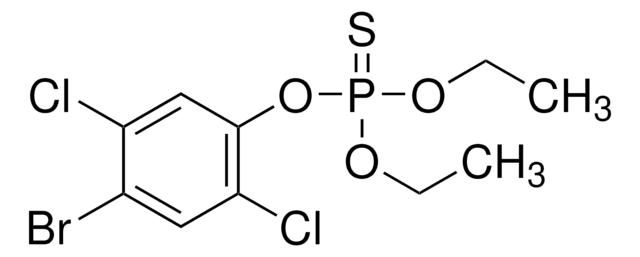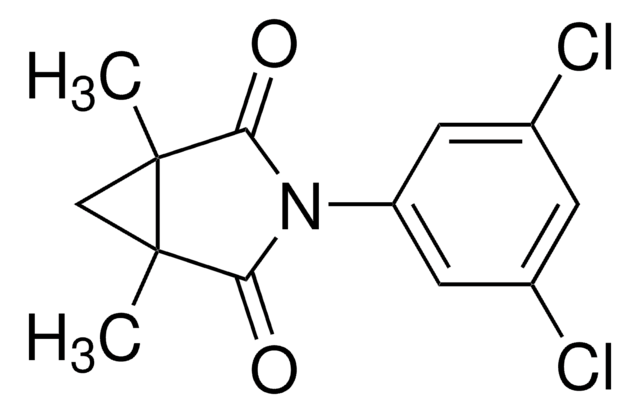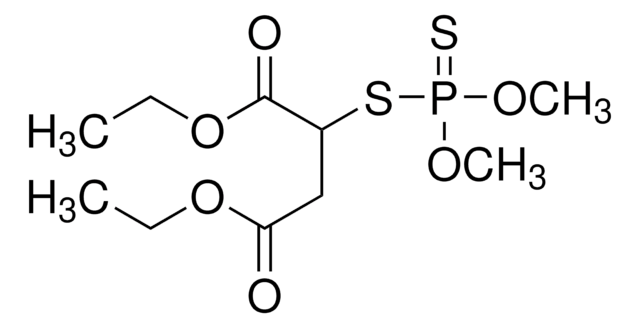Kluczowe dokumenty
45332
Azinphos-ethyl
PESTANAL®, analytical standard
About This Item
Polecane produkty
klasa czystości
analytical standard
Poziom jakości
linia produktu
PESTANAL®
okres trwałości
limited shelf life, expiry date on the label
metody
HPLC: suitable
gas chromatography (GC): suitable
Zastosowanie
agriculture
environmental
Format
neat
temp. przechowywania
2-8°C
ciąg SMILES
CCOP(=S)(OCC)SCN1N=Nc2ccccc2C1=O
InChI
1S/C12H16N3O3PS2/c1-3-17-19(20,18-4-2)21-9-15-12(16)10-7-5-6-8-11(10)13-14-15/h5-8H,3-4,9H2,1-2H3
Klucz InChI
RQVGAIADHNPSME-UHFFFAOYSA-N
Szukasz podobnych produktów? Odwiedź Przewodnik dotyczący porównywania produktów
Opis ogólny
Zastosowanie
- Próbkach wody metodą ekstrakcji do fazy stałej (SPE) i ultra wysokosprawnej chromatografii cieczowej z kwadrupolową spektrometrią mas czasu przelotu (UHPLC-QqTOF-MS).
- Zboża za pomocą ekstrakcji QuEChERS (szybka, łatwa, tania, skuteczna, wytrzymała i bezpieczna) i chromatografii gazowej - spektrometrii mas z potrójnym kwadrupolem (GC-QqqQ MS/MS).
- Owoce i warzywa i neutraceutyki pochodzące z ekstraktów z pestek winogron za pomocą ekstrakcji QuEChERS i UHPLC-QqQ MS/MS ze źródłem jonizacji elektrorozpryskowej (ESI) i trybem wykrywania wielokrotnego monitorowania reakcji (MRM).
- Próbki wody morskiej metodą SPE i LC-ESI-MS/MS.
Informacje prawne
Hasło ostrzegawcze
Danger
Zwroty wskazujące rodzaj zagrożenia
Zwroty wskazujące środki ostrożności
Klasyfikacja zagrożeń
Acute Tox. 2 Oral - Acute Tox. 3 Dermal - Aquatic Acute 1 - Aquatic Chronic 1
Kod klasy składowania
6.1A - Combustible, acute toxic Cat. 1 and 2 / very toxic hazardous materials
Klasa zagrożenia wodnego (WGK)
WGK 3
Temperatura zapłonu (°F)
Not applicable
Temperatura zapłonu (°C)
Not applicable
Środki ochrony indywidualnej
dust mask type N95 (US), Eyeshields, Faceshields, Gloves, type P2 (EN 143) respirator cartridges
Wybierz jedną z najnowszych wersji:
Certyfikaty analizy (CoA)
Nie widzisz odpowiedniej wersji?
Jeśli potrzebujesz konkretnej wersji, możesz wyszukać konkretny certyfikat według numeru partii lub serii.
Masz już ten produkt?
Dokumenty związane z niedawno zakupionymi produktami zostały zamieszczone w Bibliotece dokumentów.
Klienci oglądali również te produkty
Protokoły
analytical standard; Tokuthion, technical grade, pkg of 50 mg; Crotoxyphos; Phorate; Azinphos-ethyl; Diazinon; Azinphos-methyl; Demeton-O; Dimethoate; Chlorpyrifos-methyl
Test your food for fipronil contamination using our analytical standards, certified reference materials, solvents, and columns for analysis.
Nasz zespół naukowców ma doświadczenie we wszystkich obszarach badań, w tym w naukach przyrodniczych, materiałoznawstwie, syntezie chemicznej, chromatografii, analityce i wielu innych dziedzinach.
Skontaktuj się z zespołem ds. pomocy technicznej